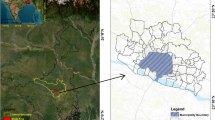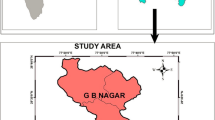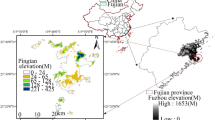Abstract
Spatio-temporal land-use land-cover changes have a long-term impact on urban environments. The present study is based on land-use land-cover changes and urban expansion of megacity Kolkata and its environs over three decades (1991–2018) using multitemporal Landsat data. The study aims to explore and explain the spatio-temporal land-use land-cover change, areal differentiation, spatio-temporal urban growth trajectory and future land-use land-cover prediction with population projection. The spatio-temporal representation found rapid urbanization, i.e. 19% to 57%, exactly three times as in 1991, resulting in significant loss of other than urban/built-up area. Urban trajectory reveals that the expansion mainly occurred in north-east to south-west direction, the zone of both sides of River Hooghly. Areal differentiation map with highest urbanization (3146 ha or UII = 0.64) was identified in the north–north-west part, while least urbanization was identified in the east–north-east direction. On the other hand, this urbanization has grabbed most (i.e. 87%) of the areas within 5-km ring buffer compared to other three ring buffers. Being Kolkata as a traditional city, it has all modern facilities since British rule; as a result, the high population growth and rapid urban expansion were explored in the study. Therefore, urban growth led to radical changes in land-use land-cover, which were witnessed by sharp decreases in sparse vegetation and fallow land. The correlation explained that increasing urbanization has decreased the amount of water body and vegetation. The future prediction graph identified the more horrible picture: the city and its environs will be covered by 67% built-up, while there will be only 3% water body, 14% vegetation and 16% fallow land of the total geographical area with a population (projection) of 28 million in 2051 if it is continued. Such expansion will create a wide range of mismanagement and environmental problems. Hence, the intensive explanation and areal differentiation maps and diagrams prepared using geospatial data will definitely help to understand the urban growth dynamics process and changing form of land-use land-cover and simultaneously decision-making process of the local planners, stakeholders and academicians. Therefore, it also guides to future planning to decrease the adverse effects of urbanization and result in the form of land-use land-cover and makes an eco-friendly megacity as well as sustainable urban development too.














Similar content being viewed by others
References
Ali, A. M. S. (2006). Rice to shrimp: Land use/land covers changes and soil degradation in southwestern Bangladesh. Land Use Policy, 23(4), 421–435.
Bagan, H., & Yamagata, Y. (2014). Land-cover change analysis in 50 global cities by using a combination of Landsat data and analysis of grid cells. Environmental Research Letters, 9, 1–13.
Bardhan, R., Kurisu, H. K., & Keisuke, H. (2011). Linking urban form and quality of life in Kolkata, India. 47th ISOCARP Congress 2011.
Baker, W. L. (1989). A review of models of landscape change. Landscape Ecology, 2, 111–133.
Belal, A. A., & Moghanm, F. S. (2011). Detecting urban growth using remote sensing and GIS techniques in Al Gharbiya governorate, Egypt. Egyptian Journal of Remote Sensing and Space Science, 14, 78–79.
Berling-Wolff, S., & Wu, J. (2004). Modeling urban landscape dynamics: A case study in Phoenix, USA. Urban Ecosystems, 7(3), 215–240.
Bhat, P. A., Shafiq, M. U., Mir, A. A., & Ahmed, P. (2017). Urban sprawl and its impact on land-use/land cover dynamics of Dehradun City, India. International Journal of Sustainable Built Environment, 6(2), 513–521.
Bhatta, B. (2010). Analysis of urban growth and sprawl from remote sensing data. Berlin: Springer.
Brenner, N., & Schmid, C. (2015). Towards a new epistemology of the urban? City, 19(2–3), 151–182.
Byomkesh, T., Nakagoshi, N., & Dewan, A. M. (2012). Urbanization and green space dynamics in greater Dhaka, Bangladesh. Landscape and Ecological Engineering, 8(1), 45–58.
Census of India. (2011). http://www.censusindia.gov.in/2011census/. Accessed 5 Jan 2018.
Cohen, J. (1960). A coefficient of agreement for nominal scales. Educational and Psychological Measurement, 20, 37–46.
Coppin, P., Jonckheere, I., Nackaerts, K., Muys, B., & Lambin, E. (2004). Digital change detection methods in ecosystem monitoring: A review. International Journal of Remote Sensing, 25(9), 1565–1596.
Dewan, A. M., & Yamaguchi, Y. (2009a). Using remote sensing and GIS to detect and monitor land use and land cover change in Dhaka Metropolitan of Bangladesh during 1960–2005. Environmental Monitoring and Assessment, 150(1–4), 237–249.
Dewan, A. M., & Yamaguchi, Y. (2009b). Land use and land cover change in greater Dhaka, Bangladesh: Using remote sensing to promote sustainable urbanization. Applied Geography, 29(3), 390–401.
Dewan, A. M., Yamaguchi, Y., & Rahman, M. Z. (2012). Dynamics of land use/cover changes and the analysis of landscape fragmentation in Dhaka Metropolitan. Bangladesh Geojournal, 77(3), 315–330.
Du, S., Shi, P., & Rompaey, A. V. (2013). The relationship between urban sprawl and farmland displacement in the Pearl River Delta, China. Land, 3, 34–51.
Estoque, R. C., & Murayama, Y. (2015). Intensity and spatial pattern of urban land changes in the megacities of Southeast Asia. Land Use Policy, 48, 213–222.
Estoque, R. C., & Murayama, Y. (2016). Quantifying landscape pattern and ecosystem service value changes in four rapidly urbanizing hill stations of Southeast Asia. Landscape Ecology, 31, 1–27.
Grimm, N. B., Grove, J. M., Picket, S. T. A., & Redman, C. L. (2000). Integrated approaches to long-term studies of urban ecological systems. BioScience, 50(7), 571–584.
Guan, D., Li, H., Inohae, T., Su, W., Nagaie, T., & Hokao, K. (2011). Modeling urban land use change by the integration of cellular automaton and Markov model. Ecological Modelling, 222, 3761–3772.
Haas, J., & Ban, Y. (2014). Urban growth and environmental impacts in Jing-Jin-Ji, the Yangtze, River Delta and the Pearl River Delta. International Journal of Applied Earth Observation and Geoinformation, 30, 42–55.
Halmy, A. W. H., Gessler, P. E., Hicke, J. A., & Salem, B. B. (2015). Land use/land cover change detection and prediction in the north-western coastal desert of Egypt using Markov–CA. Applied Geography, 63, 101–112.
Hass, J., Dorothy, F., & Yifan, B. (2015). Satellite monitoring of urbanization and environmental impacts—A comparison of Stockholm and Shanghai. International Journal of Applied Earth Observation and Geoinformation, 38, 138–149.
Hassan, M. M. (2017). Monitoring land use/land cover change, urban growth dynamics and landscape pattern analysis in five fastest urbanized cities in Bangladesh. Remote Sensing Applications: Society and Environment, 7(2017), 69–83.
He, C., Liu, Z., Tian, J., & Ma, Q. (2014). Urban expansion dynamics and natural habitat loss in China: A multiscale landscape perspective. Global Change Biology, 20(9), 2886–2902.
Islam, N. (2011). Urbanization in Bangladesh. International seminar on urbanization. Asiatic Society of Bangladesh, Dhaka.
Jain, M. (2017). Contemporary urbanization as unregulated growth in India: The story of census towns. Cities, 73(2018), 117–127.
Jain, A., Siddiqui, A., Tiwari, P. S., & Shashi, M. (2016). Urban growth assessment using CA Markov model: A case study of Dehradun City. 9th International Geographic Union 2016.
Jat, M. K., Garg, P. K., & Khare, D. (2008). Modeling urban growth using spatial analysis techniques: A case study of Ajmer city (India). International Journal of Remote Sensing, 29(2), 543–567.
Kar, R., Reddy, G. P. O., Kumar, N., & Singh, S. K. (2018). Monitoring spatio-temporal dynamics of urban and peri-urban landscape using remote sensing and GIS—A case study from Central India. Egyptian Journal of Remote Sensing and Space Science, 21(3), 401–411.
Kaushal, S. S., McDowell, W. H., & Wollheim, W. M. (2014). Tracking evolution of urban biogeochemical cycles: Past, present, and future. Biogeochemistry, 121(1), 1–21.
Kennedy, C. A., Stewart, I., Facchini, A., Cersosimo, I., Mele, R., Chen, B., et al. (2015). Energy and material flows of megacities. Proceedings of National Academy of Sciences, 112(19), 5985–5990.
Kolkata Municipal Corporation. https://www.kmcgov.in/KMCPortal/jsp/KolkataStatistics.jsp. Accessed 13 Jan 2018.
Kong, F., & Nakagoshi, N. (2006). Spatial-temporal gradient analysis of urban green spaces in Jinan, China. Landscape and Urban Planning, 78, 147–164.
Lillesand, T. M., Kiefer, R. W., & Chipman, J. W. (2017). Remote sensing and image interpretation (p. 590). Hoboken: Wiley.
Liu, Y., Chen, J., & Cheng, W. (2014). Spatiotemporal dynamics of the urban sprawl in a typical urban agglomeration: A case study on Southern Jiangsu, China (1983–2007). Frontiers of Earth Science, 8(4), 490–504.
Liu, M., Tian, H., & Chen, G. (2008). Effects of land-use and land cover change on evapotranspiration and water yield in China during 1900–2000. Journal of the American Water Resources Association, 44(5), 1193–1207.
Lu, D., Mausel, P., Brondiozio, E., & Moran, E. (2004). Change detection techniques. International Journal of Remote Sensing, 25(12), 2365–2407.
Mandal, R. B. (2000). Urban geography—A textbook (pp. 251–258). New Delhi: Concept Publishing Company.
Mukhopadhyay, A., Mukherjee, S., Garg, R. D., & Ghosh, T. (2013). Spatio-temporal analysis of land use—Land cover changes in Delhi using remote sensing and GIS techniques. International Journal of Geomatics and Geosciences, 4(1), 213–223.
Muller, M. R., & Middleton, J. (1994). A Markov model of land-use change dynamics in the Niagara Region, Ontario, Canada. Landscape Ecology, 9, 151–157.
Mundia, C. N., & Aniya, M. (2006). Dynamics of land use/cover changes and degradation of Nairobi City Kenya. Land Degradation and Development, 17(1), 97–108.
Mundia, C. N., & Murayama, Y. (2010). Modeling spatial processes of urban growth in African cities: A case study of Nairobi City. Urban Geography, 31(2), 259–272.
Nandi, R. P. (2008). Issues causing disaster in the life of people of Kolkata and their web of management. http://siteresources.worldbank.org/CMUDLP/Resources/RUDRAPRASADNANDIBestProject.pdf. Accessed 30 May 2019.
New Climate Economy Report. (2014). The Global Commission on the Economy and Climate.
Olaode, A., Naghdy, G., & Todd, C. (2014). Unsupervised classification of images: A review. International Journal of Image Processing (IJIP), 8(5), 324–342.
Open topography, high-resolution topography data and tools, shuttle radar topography mission (SRTM GL1) global 30 m ellipsoidal. http://opentopo.sdsc.edu/lidar?format=sd. Accessed 21 Mar 2018.
Parsa, V. N., & Salehi, E. (2016). Spatio-temporal analysis and simulation pattern of land use/cover changes, case study: Naghadeh, Iran. Journal of Urban Management, 5, 43–51.
Paul, A., & Sen, J. (2018). Livability assessment within a metropolis based on the impact of integrated urban geographic factors (IUGFs) on clustering urban centers of Kolkata. Cities, 74, 142–150.
Pickett, S. T. A., Cadenasso, M. L., Grove, J. M., Nilon, C. H., Pouyat, R. V., & Zipperer, W. C. (2001). Urban ecological systems: Linking terrestrial ecological, physical, and socioeconomic components of metropolitan areas. Annual Review of Ecology and Systematics, 32, 127–157.
Porio, E. (2014). Sustainable development goals and quality of life targets: Insights from Metro Manila. Current Sociology, 63(2), 244–260.
Priyadharshin, P. K., & Suresh, B. S. (2018). Urban sprawl modelling for then using RS and GIS. International Journal of Advance Research, Ideas and Innovations in Technology, 4(2), 553–559.
Qi, Z.-F., Ye, X., Zhang, H., & Yu, Z.-L. (2014). Land fragmentation and variation of ecosystem services in the context of rapid urbanization: The case of Taizhou city, China. Stochastic Environmental Research and Risk Assessment, 28(4), 843–855.
Ramachandra, T. V., Bharath, H. A., & Sowmyashree, M. V. (2014). Urban structure in Kolkata: Metrics and modelling through geo-informatics. Applied Geomatics, 6(4), 229–244.
Sengupta, S. (2007). Status of Kolkata megacity disaster management system in view of recent natural disasters. http://siteresources.worldbank.org/CMUDLP/Resources/SamanjitSengupta.pdf. Accessed 31 May 2019.
Shaw, R., & Das, A. (2017). Identifying peri-urban growth in small and medium towns using GIS and remote sensing technique: A case study of English Bazar Urban Agglomeration, West Bengal, India. The Egyptian Journal of Remote Sensing and Space Sciences, 21(2), 159–172.
Siddiqui, A., Siddiqui, A., Maithani, S., Jha, A. K., Kumar, P., & Srivastav, S. K. (2017). Urban growth dynamics of an Indian metropolitan using CA Markov and logistic regression. The Egyptian Journal of Remote Sensing and Space Sciences, 21(3), 229–236.
Su, S., Jiang, Z., Zhang, Q., & Zhang, Y. (2011). Transformation of agricultural landscapes under rapid urbanization: A threat to sustainability in Hang-Jia-Hu region, China. Applied Geography, 31(2), 439–449.
Suja, R., Letha, J., & Varghese, J. (2013). Evaluation of urban growth and expansion using remote sensing and GIS. The International Journal of Engineering Research and Technology (IJERT), 2(10), 2772–2779.
Sun, L., Wei, J., Duan, D. H., Guo, Y. M., Yang, D. X., Jia, C. (2016). Impact of land-use and land-cover change on urban air quality in representative cities of China. The Journal of Atmospheric and Solar-Terrestrial Physics, 142, 43–54.
Sun, Y., & Zhao, S. (2018). Spatiotemporal dynamics of urban expansion in 13 cities across the Jing-Jin-Ji Urban Agglomeration from 1978 to 2015. Ecological Indicators, 87(2018), 302–313. https://doi.org/10.1016/j.ecolind.2017.12.038.
Swanwick, C., Dunnett, N., & Woolley, H. (2003). Nature, role and value of green spaces in towns and cities: An overview. Built Environment, 29(2), 94–106.
Tate, C. M., Coles, J. F., & Zappia, H. (2005). Use of an urban intensity index to assess urban effects on streams in three contrasting environmental settings. American Fisheries Society Symposium, 47, 291–315.
Turner, B. L., Lambin, E. F., & Reenberg, A. (2007). The emergence of land change science for global environmental change and sustainability. PNAS, 104, 20666–20671.
UNDP/UNFPA, UNICEF & WEP. (2009). Draft report on agenda item 1: Population growth and rapid urbanization: Food insecurity on the rise in urban settings. New York. https://www.unicef.org/about/execboard/files/B-8713E-JMB_Jan_09-population_growth.pdf. Accessed 5 May 2019.
UNFPA. State of the world population 2007: Unleashing the potential of urban growth.
United States Census Bureau. https://census.gov/programs-surveys/popproj.html. Accessed 21 Jan 2018.
USGS, science for a changing worth, Earth Explorer. http://earthexplorer.usgs.gov. Accessed 2 Jan 2018.
Veldkamp, A., & Lambin, E. F. (2001). Predicting land-use change. Agriculture, Ecosystems & Environment, 85, 1–6.
Weber, C., & Puissant, A. (2003). Urbanization pressure and modeling of urban growth: Example of the Tunis metropolitan area. Remote Sensing of Environment, 86(3), 341–352.
Wei, J., Sun, L., & Liu, S. (2015). Response analysis of particulate air pollution to land-use and land-cover change. Acta Ecologica Sinica, 35(16), 5495–5506.
Wu, J., Jenerette, G. D., Buyantuyev, A., & Redman, C. L. (2011). Quantifying spatiotemporal patterns of urbanization: The case of the two fastest growing metropolitan regions in the United States. Ecological Complexity, 8(1), 1–8.
Yadav, N., & Sharma, C. (2018). Spatial variations of intra-city urban heat island in megacity Delhi. Sustainable Cities and Society, 37, 298–306.
Yirsaw, E., Wu, W., Shi, X., Temesgen, H., & Bekele, B. (2017). Land use/land cover change modeling and the prediction of subsequent changes in ecosystem service values in a coastal area of China, the Su-Xi-Chang Region. Sustainability, 9, 1–17.
Zhang, Y., & Song, C. (2006). Impacts of afforestation, deforestation, and reforestation on forest cover in China from 1949 to 2003. Journal of Forestry, 104(7), 383–387.
Zhou, D., Shi, P., Wu, X., Ma, J., & Yu, J. (2014). Effects of Urbanization Expansion on Landscape Pattern and Region Ecological Risk in Chinese Coastal City: A Case Study of Yantai City. The Scientific World Journal, 2014. 821781.
Author information
Authors and Affiliations
Corresponding author
Additional information
Publisher's Note
Springer Nature remains neutral with regard to jurisdictional claims in published maps and institutional affiliations.
About this article
Cite this article
Mandal, J., Ghosh, N. & Mukhopadhyay, A. Urban Growth Dynamics and Changing Land-Use Land-Cover of Megacity Kolkata and Its Environs. J Indian Soc Remote Sens 47, 1707–1725 (2019). https://doi.org/10.1007/s12524-019-01020-7
Received:
Accepted:
Published:
Issue Date:
DOI: https://doi.org/10.1007/s12524-019-01020-7




